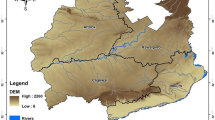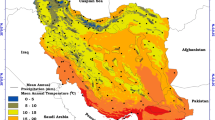Abstract
The climate change is one of the most important challenges facing the environment. In this study, climate change by air temperature and precipitation parameters is evaluated and compared for observational and future data. For the baseline period (1981–2016) and for future (2020–2080) detemined. To estimate future data, utilized the CNRM-CM5 and HadGEM2-ES models output the global climate models (GCMs) from the MarksimGCM database and the CNRM-CERFACS and MIROC-ESM models as regional climate models (RCMs) from the CORDEX project for the domain of south Asia is based on the representation concentration pathway RCP8.5 and RCP4.5 scenarios were considered. The results showed that is an increasing and decreasing trend for air temperature and precipitation in the baseline period, respectively. The validation of the models showed that the CNRM-CM5 model as a GCM model and the CNRM-CERFACS model as an RCM model have a higher performance in simulating climate change for study area. In fact, output of these models have close relation to the observed data. Evaluation of the temperature components (minimum and maximum temperatures) showed these components had an increasing trend in the baseline period and would have an upward deviation in the future. With respect to the changes in air temperature, precipitation and reference evapotranspiration (Eto) for the future, the status of water resources in the study area will decline significantly. Therefore, the effects of climate change are significant for the study area, which need to consider adaptive strategies such as; optimal water management, cropping pattern and resource management.













Similar content being viewed by others
References
Ahmadi H, Ghalhari GF, Baaghideh M (2019) Impacts of climate change on apple tree cultuvation areas in Iran. Clim Change 153(1–2):91–103
Ansari S Massah Bavani, Roozbahani A (2016) Effects of climate change on groundwater recharge (case study: Sefid Dasht plain). J Water Soil 30(2):416–431
Bates B, Kundzewicz Z, Wu S (2008) IPCC Technical paper on climate change and water. Ntergovernmental panel on climate change secretariat. Climate change and water. Cambridge University Press, Cambridge
Chen H, Xu CY, Guo S (2012) Comparison and evaluation of multiple GCMs, statistical downscaling and hydrological models in the study of climate change impacts on runoff. J Hydrol 434:36–45
Christensen NS, Wood AW, Voisin N, Lettnmarier DP, Palmer RN (2004) The effects of climate change on hydrology and water resources of the colorado river basin. Clim Change 62:337–363
Djaman K, Balde AB, Sow A, Muller B, Irmak S, Diaye MKN, Manneh B, Moukoumbi YD, Futakuchi K, Saito K (2015) Evaluation of sixteen reference evapotranspiration methods under sahelian conditions in the Senegal River Valley. J Hydrol Reg Stud 3(2015):139–159
Fronzek S, Carter TR (2007) Assessing uncertainties in climate change impacts on resource potential for Europe based on projections from RCMs and GCMs. Clim Change 81(1):357–371
Gebrechorkos SH, Bernhofer C, Hülsmann S (2019) Impacts of projected change in climate on water balance in basins of East Africa. Sci Total Environ 682:160–170
Giorgi F, Jones C, Asrar GR (2006) Addressing climate information needs at the regional level: the CORDEX framework. Bull World Meteorol Organ 58(3):175–183
Jones PG, Thornton PK (2013) Generating downscaled weather data from a suite of climate models for agricultural modelling applications. Agric Syst 114:1–5
Jones C, Giorgi F, Asrar G (2011) The coordinated regional downscaling experiment: CORDEX An international downscaling link to CMIP. CLIVAR Exchanges 16(2):34–40
Joseph J, Ghosh S, Pathak A, Sahai AK (2018) Hydrologic impacts of climate change: comparisons between hydrological parameter uncertainty and climate model uncertainty. J Hydrol 566:1–22
Karimi H, Naderi F, Mehdizadeh Z (2011) Preparation of irrigation capability map of Mehran plain water in GIS environment. J Irrig Water Eng 2(6):1–9
McCarthy JJ, Canziani OF, Leary NA, Dokken DJ, White KS (Eds) (2001) Climate change 2001: impacts, adaptation, and vulnerability: contribution of Working group II to the third assessment report of the Intergovernmental Panel on Climate Change, vol 2. Cambridge University Press, Cambridge
Nouri M, Homaee M, Bannayan M, Hoogenboom G (2017) Towards shifting planting date as an adaptation practice for rainfed wheat response to climate change. Agric Water Manag 186:108–119
Raziei T, Pereira L (2013) Estimation of Eto with Hargreaves—Samani and FAO-PM temperature methods for a wide range of climates in Iran. Agric Water Manag 121:1–18
Shresths S, Bajjracharya AR, Babel MS (2016) Assessment of risks due to climate change for the Upper Tamakoshi Hydropower Project in Nepal. Clim Risk Manag 14:27–41
Singh V, Goyal MK (2016) Analysis and trends of precipitation lapse rate and extreme indices over north Sikkim eastern Himalayas under CMIP5ESM-2 M RCPs experiments. Atmos Res 1(167):34–60
Singh V, Jain SK, Singh PK (2019) Inter-comparisons and applicability of CMIP5 GCMs, RCMs and statistically downscaled NEX-GDDP based precipitation in India. Sci Total Environ 697:1–18
Tabari H, Somee BS, Zadeh MR (2011) Testing for long-term trends in climatic variables in Iran. Atmos Res 100:132–140
Tapiador FJ, Moreno R, Navarro A, Sánchez JL, García-Ortega E (2019) Climate classifications from regional and global climate models: Performances for present climate estimates and expected changes in the future at high spatial resolution. Atmos Res 228:107–121
Xue Y, Janjic Z, Dudhia J, Vasic R De, Sales F (2014) A review on regional dynamical downscaling in intraseasonal to seasonal simulation/prediction and major factors that affect downscaling ability. Atmosph Res 1(147):68–85
Acknowledgements
Authors would like to thank the Islamic Republic of Iran Meteorological Organization (IRIMO) and the Regional Water Company of Ilam (RWCI) for providing the necessary data.
Author information
Authors and Affiliations
Corresponding author
Additional information
Publisher's Note
Springer Nature remains neutral with regard to jurisdictional claims in published maps and institutional affiliations.
Rights and permissions
About this article
Cite this article
Ahmadi, H., Azizzadeh, J. The impacts of climate change based on regional and global climate models (RCMs and GCMs) projections (case study: Ilam province). Model. Earth Syst. Environ. 6, 685–696 (2020). https://doi.org/10.1007/s40808-020-00721-0
Received:
Accepted:
Published:
Issue Date:
DOI: https://doi.org/10.1007/s40808-020-00721-0




